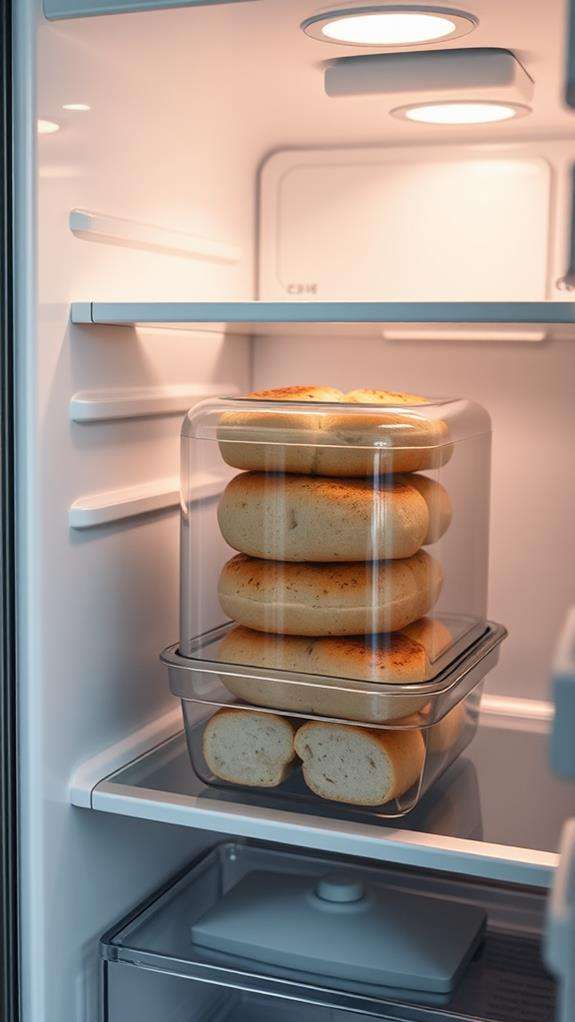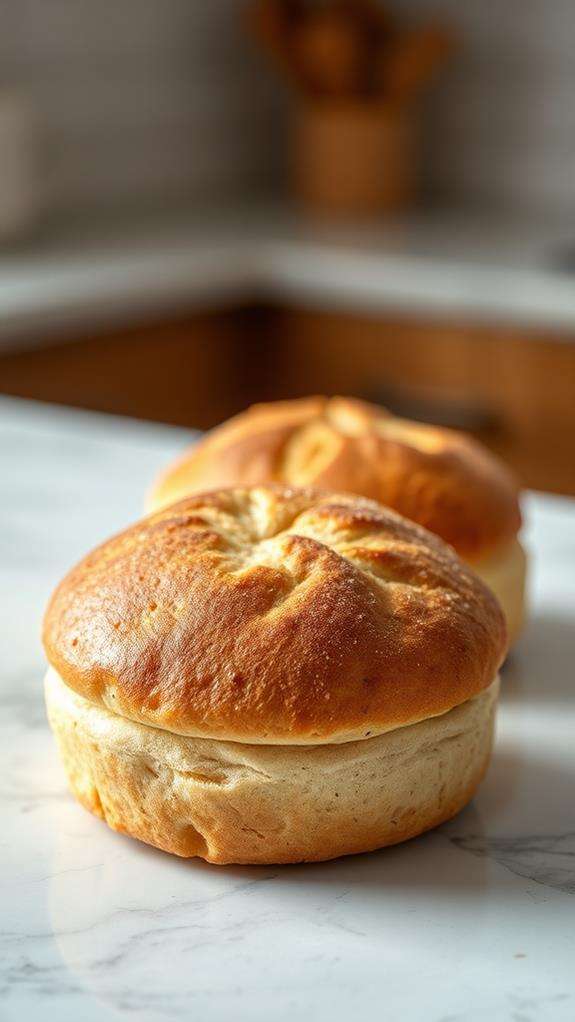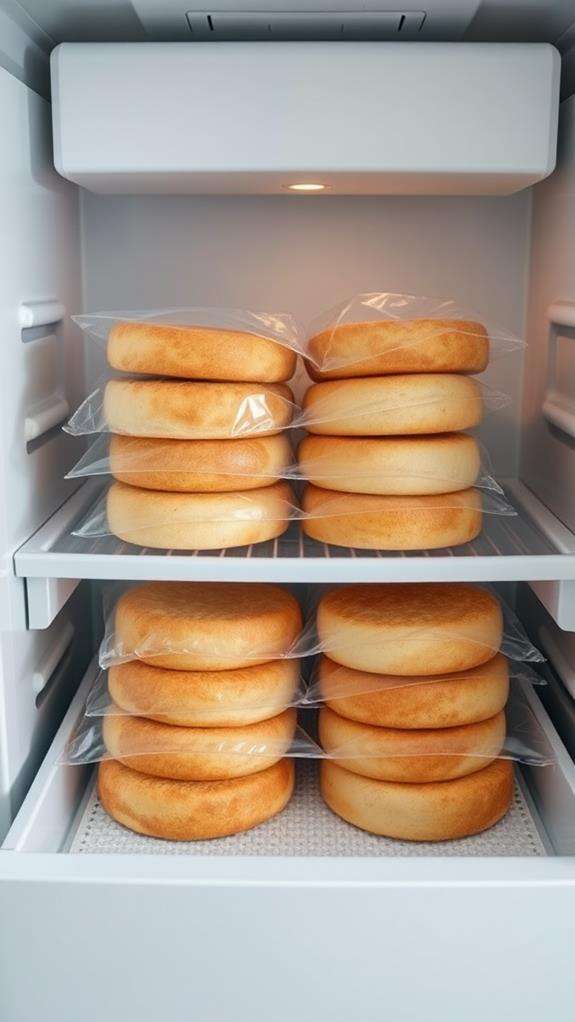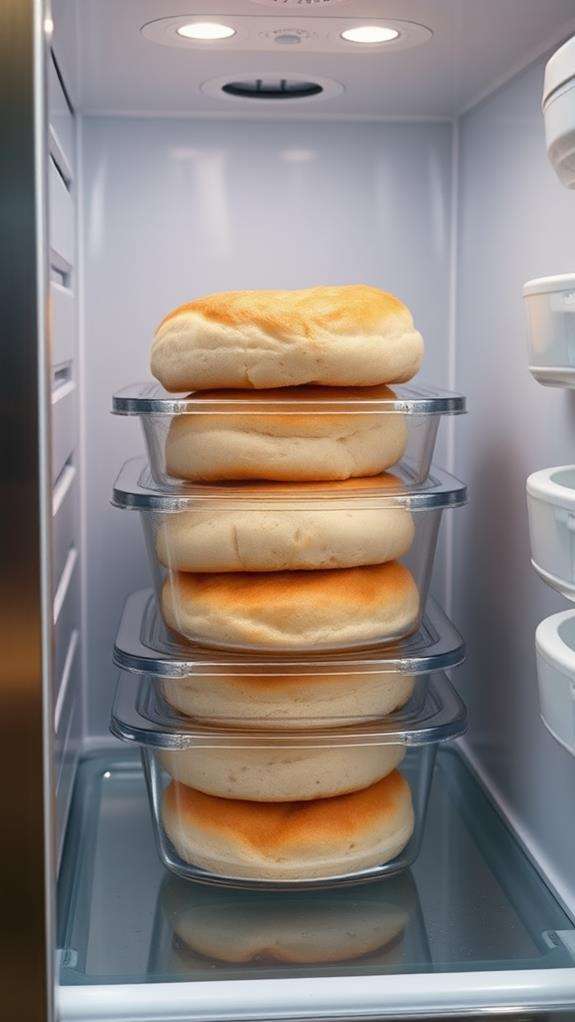How Long Do English Muffins Last in the Fridge
English muffins will last about 2-3 weeks in your refrigerator when stored properly in an airtight container or sealed plastic bag. You'll need to keep them at a consistent temperature between 35-40°F (1.7-4.4°C) and protect them from excess moisture, which can lead to mold growth. While they'll stay fresh for only 4-5 days at room temperature, refrigeration considerably extends their shelf life. Watch for signs of spoilage like unusual odors, discoloration, or fuzzy spots. If you're planning for longer storage, you can freeze them for up to 6 months. Understanding proper storage techniques can help you maximize your English muffins' freshness and prevent waste.
This post may contain affiliate links. If you make a purchase through these links, I may earn a commission at no additional cost to you. Additionally, portions of this post may be generated using artificial intelligence (AI) technology. While we strive for accuracy, please be aware that AI-generated content may not always be perfect and should be fact-checked when necessary.
The Spatula Scoops
- English muffins typically last 1 to 2 weeks when stored properly in the refrigerator at temperatures between 35-40°F.
- Store muffins in an airtight container or resealable plastic bag with excess air removed to maximize freshness.
- Signs of spoilage include mold growth, unusual odors, discoloration, or changes in texture from firm to mushy.
- Double-wrap original packaging with plastic wrap or aluminum foil to create an effective moisture barrier.
- Monitor storage dates by labeling packages, and keep muffins away from strong odors and high-humidity areas in the fridge.
Shelf Life Basics

English muffins' shelf life varies considerably based on storage conditions. When you're storing these breakfast staples, you'll find that room temperature storage typically gives you 4-5 days of freshness, while refrigeration extends this period to 2-3 weeks. If you've purchased commercially packaged English muffins, you'll notice they come with a "best by" date, though this isn't necessarily an expiration date.
You'll want to take into account several factors that affect shelf life, including the muffins' moisture content, preservatives, and packaging integrity. Store-bought varieties containing preservatives will naturally last longer than fresh-baked ones from your local bakery. When you're checking for freshness, look for visible mold, unusual odors, or texture changes that might indicate spoilage. If you're planning to store your English muffins beyond their typical shelf life, you can freeze them for up to 6 months while maintaining quality. The freezer temperature should be at or below 0°F (-18°C) for ideal preservation. Each time you remove muffins from storage, you'll want to inspect them carefully before consumption, even if they're within their recommended storage period.
Proper Storage Methods

To maximize freshness, storing English muffins properly requires several key steps. You'll need to take into account factors like temperature control, packaging materials, and moisture prevention to guarantee your English muffins stay fresh for as long as possible. The refrigeration process, when done correctly, can greatly extend their shelf life beyond room-temperature storage.
- Place your English muffins in an airtight container or resealable plastic bag, removing as much air as possible to prevent freezer burn and moisture absorption.
- If storing the original packaging, double-wrap it with plastic wrap or aluminum foil to create an additional moisture barrier.
- Position the muffins in your refrigerator's main compartment, away from strong-smelling foods and the crisper drawer where humidity levels are higher.
- Label the package with the storage date using a permanent marker or food storage label.
You'll want to maintain a consistent refrigerator temperature between 35-40°F (1.7-4.4°C). If you're planning to store multiple packages, don't stack them too tightly, as proper air circulation helps prevent moisture buildup and potential mold growth. Think about using specially designed bread storage containers with ventilation features for prime results.
Signs of Spoilage

Checking your English muffins for signs of spoilage involves looking for visual changes like discoloration, unusual spots, or any traces of mold, which typically appears as green, blue, or white patches. You'll want to pay attention to texture changes, as spoiled English muffins often become unusually hard, excessively dry, or develop an unpleasant, slimy feel when touched. If you notice any musty, sour, or off-putting odors when you open the package, it's a clear indication that your English muffins have gone bad and should be discarded immediately.
Visual Changes
Spotting visual changes in your English muffins can help determine if they've gone bad. When examining your muffins, pay close attention to their appearance, as visual indicators often provide the first warning signs of spoilage. The texture and color of your English muffins will typically change as they deteriorate.
- Mold growth appears as fuzzy spots in various colors (green, white, black, or blue), typically starting in the nooks and crannies where moisture tends to collect
- Discoloration develops in the form of dark or unusual spots that weren't present when you purchased the muffins, often appearing as yellow or brown patches
- Structural changes occur when the muffins become unusually dry, causing them to crumble or develop an abnormally hard texture that's different from their original state
- Surface alterations manifest as unusual sheen or sticky residue, which can indicate bacterial growth or moisture damage
If you notice any of these visual changes, it's best to discard the English muffins immediately. Don't attempt to salvage partially affected muffins by removing the problematic areas, as microscopic spores may have spread throughout the entire product.
Texture and Firmness
Beyond visual inspection, changes in texture and firmness serve as critical indicators of English muffin spoilage. When you're examining your refrigerated English muffins, you'll want to pay close attention to how they feel when you handle them.
Fresh English muffins should maintain a slightly firm yet springy texture, even when refrigerated. If you notice they've become unusually hard or brittle, that's a sign they're beginning to stale. You'll also want to check for any spots that feel unusually soft or mushy, as this often indicates moisture accumulation and potential mold growth beneath the surface. When you press gently on the muffin's surface, it should bounce back slightly; if it doesn't recover its shape or feels dense and compressed, it's likely past its prime.
Another telltale sign is when your English muffins develop a rubbery or leathery consistency. If they've become so firm that they're difficult to split with a fork (the traditional method), or if they crumble apart instead of maintaining their characteristic texture, you'll want to contemplate discarding them, as these changes suggest significant quality degradation.
Off Smells Developing
Your nose can be one of your best tools for detecting spoiled English muffins. When these breakfast staples begin to deteriorate, they'll often develop distinct odors that serve as warning signs of spoilage. You'll want to pay close attention to any unusual smells coming from your stored muffins, as these can indicate that it's time to discard them.
Common smell indicators that your English muffins have spoiled include:
- A musty, damp odor that resembles wet cardboard, which typically indicates mold growth has begun even if you can't see it yet
- Sour or fermented smells, suggesting bacterial growth has started to break down the ingredients
- A sharp, vinegar-like aroma that wasn't present when you first purchased the muffins
- Rancid or "off" scents coming from the oils in the bread, particularly if they've been stored for several months
If you detect any of these odors, don't take chances with your health. While properly stored English muffins should maintain their fresh, slightly yeasty smell for up to two weeks in the refrigerator, any deviation from this normal scent indicates it's time for disposal.
Room Temperature Vs Refrigeration

The two main storage methods for English muffins present different benefits and timeframes for keeping them fresh. At room temperature, you'll find your muffins will last about 5-7 days when stored in an airtight container or sealed plastic bag. This method maintains their original texture and prevents them from becoming too moist or developing condensation.
Refrigeration extends your English muffins' shelf life to approximately 2 weeks, but there's a trade-off. You'll notice they become slightly firmer and may develop condensation when stored in the fridge. If you're planning to refrigerate them, you'll want to wrap them tightly in plastic wrap or place them in an airtight container with moisture-absorbing paper towels. This helps prevent humidity-related issues that can lead to premature spoilage.
Your choice between room temperature and refrigeration should depend on your consumption timeline. If you'll eat the muffins within a week, room temperature storage is ideal for maintaining optimal quality. However, if you need them to last longer, refrigeration is your best option, though you'll want to toast them before eating to restore their original texture.
Freezing English Muffins

Freezing English muffins is one of the best ways to extend their shelf life, and you'll find they can last up to 6 months when properly stored in airtight freezer bags or containers. For ideal results, you can double-wrap your English muffins in plastic wrap and aluminum foil before placing them in a freezer bag, which helps prevent freezer burn and maintain their taste and texture. When you're ready to enjoy your frozen English muffins, simply thaw them at room temperature for about an hour or pop them directly into your toaster, adding an extra minute to your usual toasting time.
Best Freezing Storage Methods
Stored properly in airtight containers or freezer bags, English muffins can maintain their quality for up to 3 months in your freezer. To achieve the best results, you'll need to focus on proper packaging techniques that prevent freezer burn and maintain the muffins' texture.
- Double-wrap each muffin individually in plastic wrap, making sure to press out any air pockets before sealing, then place them in a freezer-safe container
- If you're using freezer bags, remove as much air as possible before sealing – you can use the water displacement method or a vacuum sealer for best results
- Label each package with the date of freezing using a permanent marker to track freshness
- Consider pre-slicing the muffins before freezing to make them more convenient to use later
When you're ready to use your frozen English muffins, you can thaw them in the refrigerator overnight or pop them directly into the toaster from frozen. If you notice any ice crystals forming inside the packaging, it's a sign that air has penetrated the wrapping, which might affect the texture and taste of your muffins.
Freezer Shelf Life
Wondering about the maximum time you can keep English muffins in your freezer? When properly stored, you'll find that English muffins maintain their best quality for up to 3 months in the freezer, though they'll remain safe to eat indefinitely if kept at 0°F (-18°C) continuously.
You'll notice that frozen English muffins begin to develop freezer burn and lose their ideal texture after the 3-month mark. While they're still safe to consume beyond this timeframe, you might detect changes in taste and consistency. The muffins can become slightly dry or develop ice crystals, which affects their overall quality.
To maximize their freezer shelf life, you'll want to use airtight, freezer-safe containers or heavy-duty freezer bags. Double-wrapping the muffins in plastic wrap before placing them in freezer bags can provide additional protection against freezer burn. For best results, you should label your packages with the freezing date and try to use them within the recommended 3-month window. When you're ready to use them, thaw the muffins at room temperature or pop them directly into the toaster.
Thawing and Reheating Tips
For ideal results when thawing frozen English muffins, you'll find several effective methods at your disposal. The key is maintaining the muffin's signature texture while ensuring food safety throughout the thawing process.
- Room Temperature Method: Place your frozen muffins on a wire rack and let them thaw for 1-2 hours. Don't leave them out longer than 4 hours to prevent bacterial growth.
- Refrigerator Thawing: Transfer frozen muffins to your fridge overnight, approximately 6-8 hours. They'll maintain peak freshness and food safety this way.
- Microwave Defrost: Use your microwave's defrost setting at 30% power for 30-45 seconds. Check frequently to avoid making the muffin tough or rubbery.
- Toaster Method: You can place frozen muffins directly in your toaster, adding about 1-2 minutes to your usual toasting time.
Once thawed, you'll want to consume your English muffins within 24 hours for the best taste and texture. If you're reheating them, split them with a fork rather than a knife to preserve their signature nooks and crannies, then toast until golden brown.
Best Storage Containers

Proper storage containers play an essential role in maintaining your English muffins' freshness in the refrigerator. You'll want to choose airtight containers that can effectively block out moisture and prevent your muffins from absorbing other food odors, which can greatly impact their taste and texture. For example, leak-proof containers like the ones in the Ello Duraglass Meal Prep Set are designed specifically to keep food fresh and protected.
For ideal storage, you'll find several effective options. A rigid plastic container with a snap-on lid works well, as it prevents crushing while providing adequate protection. If you're storing multiple muffins, you can separate layers with wax paper or parchment paper to prevent sticking. Alternatively, you can use resealable plastic bags designed for bread storage, but you'll need to squeeze out excess air before sealing.
When selecting containers, look for BPA-free materials with secure seals. Glass containers with rubber gaskets offer excellent protection but may take up more space. If you're using the original packaging, transfer it to a larger resealable bag for added protection. The container should be appropriately sized – too large, and you'll trap excess air; too small, and you risk crushing the muffins.
Reviving Stale English Muffins

Even the best-stored English muffins can become stale over time, but you don't have to throw them away. With proper revitalization techniques, you can restore your English muffins to a more enjoyable texture and taste. The key is understanding how moisture and heat work together to refresh these beloved breakfast items.
Here's how you can bring your stale English muffins back to life:
- Sprinkle 2-3 drops of water on each half of the English muffin, ensuring even distribution without soaking the bread, then microwave for 15-20 seconds.
- Toast the muffin immediately after microwaving to restore its signature crispy exterior while maintaining the newly softened interior.
- Place the muffin in a 350°F oven for 5-7 minutes, wrapped loosely in foil, which helps redistribute moisture throughout the bread.
- Use your toaster oven's "defrost" setting first, then switch to regular toast mode for ideal texture restoration.
Remember that revived English muffins won't taste exactly like fresh ones, but they'll be considerably more palatable than their stale state. You'll want to consume them immediately after restoration, as they'll quickly return to their stale condition if left out.
Common Storage Mistakes

Despite their simple nature, English muffins often fall victim to several common storage blunders that markedly reduce their shelf life.
You're probably making one of these frequent mistakes: storing your muffins in their original plastic bag, which traps moisture and promotes mold growth, or leaving them on the counter without proper protection. Another critical error is placing warm English muffins directly in an airtight container, as the trapped heat creates condensation that leads to sogginess. You'll also want to avoid storing them near your stove or other heat sources, as temperature fluctuations can speed up staleness.
Don't make the mistake of refrigerating English muffins without proper wrapping – they'll quickly absorb odors from other foods and become dry. If you're using a plastic container, make sure it's completely clean and dry, as any residual moisture can become a breeding ground for bacteria. Similarly, you shouldn't stack unwrapped muffins on top of each other, as this can create humidity pockets between them. Finally, remember that repeatedly opening and closing storage containers exposes your muffins to fresh air and humidity, accelerating deterioration.
Safe Handling Tips

Safe handling of English muffins begins with clean, dry hands and utensils to prevent contamination. When you're working with these breakfast staples, it's essential to maintain proper food safety protocols to extend their shelf life and prevent mold growth. You'll want to establish a consistent routine for handling and storing your English muffins, especially if you're planning to keep them in the refrigerator.
- Always check the package seal's integrity before purchasing, as damaged packaging can expose muffins to moisture and contaminants
- Transfer muffins to an airtight container within two hours of opening the original packaging to maintain freshness
- Use clean utensils when reaching for individual muffins, avoiding direct hand contact whenever possible
- When splitting muffins, use a fork rather than a knife to preserve their signature nooks and crannies while minimizing crumbs
Remember to inspect your English muffins for signs of spoilage before consumption, checking for any discoloration or mold growth. If you're planning to freeze portions for later use, handle them minimally and wrap them tightly in moisture-barrier packaging to prevent freezer burn.
Frequently Asked Questions
Can English Muffins Be Toasted Directly From the Refrigerator?
Just like you'd toast a fresh English muffin, you can absolutely toast one straight from the fridge. While you might notice it'll take about 30 seconds longer to achieve that perfect golden-brown crunch, the extra time allows the muffin to thaw slightly during toasting. You'll want to watch it closely, though, as the moisture content from refrigeration can sometimes cause uneven browning. For best results, you might need to adjust your toaster settings slightly higher.
Why Do Store-Bought English Muffins Last Longer Than Homemade Ones?
Store-bought English muffins outlast homemade ones because they contain commercial preservatives and stabilizers that inhibit mold growth and prevent staleness. You'll find ingredients like calcium propionate, sorbic acid, and other chemical preservatives on their labels. Additionally, commercial manufacturing uses controlled environments and specialized packaging techniques that protect against moisture and bacteria, while your homemade versions rely solely on natural ingredients without these shelf-life-extending additives.
Do Different English Muffin Brands Have Different Refrigeration Shelf Lives?
You can bet your bottom dollar that different English muffin brands have varying refrigeration shelf lives. While most commercial brands like Thomas' and Bays typically last 5-7 days refrigerated, premium or organic brands might only last 3-5 days due to fewer preservatives. Store brands often fall somewhere in between. You'll want to check each package's "best by" date and storage instructions, as manufacturing processes and preservative levels differ among brands.
Can English Muffins Absorb Odors From Other Foods in the Refrigerator?
Yes, you'll find that English muffins can readily absorb odors from other foods in your refrigerator, as their porous texture makes them particularly susceptible to smell transfer. You'll want to store them in an airtight container or sealed plastic bag to protect them from picking up unwanted odors. Strong-smelling foods like onions, garlic, or certain cheeses can particularly affect your muffins' taste if they're not properly sealed.
Should English Muffins Be Separated Before Storing in the Fridge?
Yes, you'll want to separate your English muffins before refrigerating them. By splitting the muffins apart first, you're preventing them from sticking together due to moisture and condensation that can occur in the fridge. While you're at it, place wax paper or parchment between each separated half to prevent them from sticking to each other. This method will make it easier to grab individual portions when you need them.





